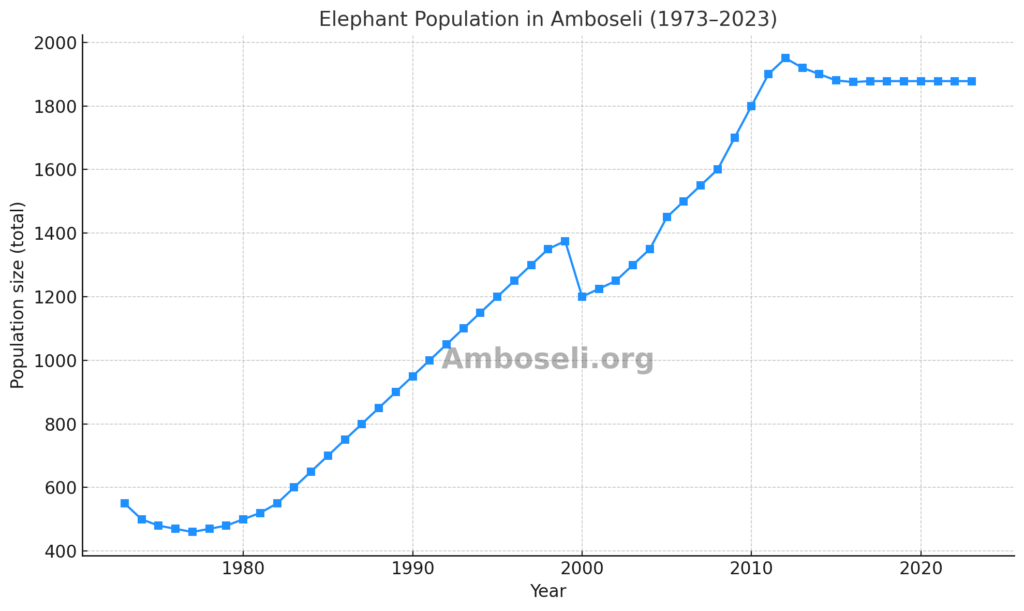🐘 Overview: One of Africa’s Most Monitored Wild Populations
The elephant population in the Amboseli ecosystem is among the most intensively studied and well-documented wildlife populations in the world. Since 1972, the Amboseli Trust for Elephants (ATE) has tracked individual elephants using visual identification, field observations, and long-term demographic analysis. This continuous effort has produced a rich, multi-generational dataset that not only informs conservation science but serves as a global model for understanding elephant social systems, reproduction, migration, and survival under ecological pressures.
📈 Population Trends: 1973 to 2023
The chart below—based on resighted known individuals—illustrates five decades of elephant population change in Amboseli.
🔹 1970s: Decline and Stabilization
- Population in 1973: ~550 elephants
- The population declined through the mid-1970s, reaching a low of ~460 due to historical poaching, habitat encroachment, and weak protective frameworks.
- Stabilization began in the late 1970s with stronger wildlife policies and the founding of AERP in 1972.
🔹 1980s–1990s: Steady Growth
- By 1985, the population rebounded to around 750 individuals.
- A steady upward trend continued through the 1990s, reaching ~1,250 by the year 2000.
- This period of growth reflects a relatively stable ecological period, low poaching rates, and successful reproduction and calf survival.

🔹 Early 2000s: Setback and Recovery
- A notable dip around 2000–2002 coincides with environmental stress, including drought conditions and disease, temporarily reducing numbers to ~1,200.
- The population quickly resumed growth, reaching ~1,600 by 2009.
🔹 2010s: Peak Population
- From 2010 to 2015, the population grew sharply, peaking at ~1,950 elephants around 2016–2017.
- This growth reflects:
- Exceptional calf survival rates
- Reduced poaching pressure due to enhanced security
- Community-led conservation initiatives such as conservancies and compensation schemes
🔹 2020s: Climate-Driven Plateau
- From 2020 to 2023, the population shows a slight decline, stabilizing at around 1,878 elephants in 2023.
- This recent drop is largely attributed to:
- Two consecutive drought years (2021–2023)
- Increased mortality among calves and aged females
- Temporary reductions in conception rates during dry periods
- Notably, even with these pressures, the population remains resilient, with strong recovery potential as shown in previous wet years.

🌍 Ecosystem Capacity and Carrying Limits
Amboseli’s elephant population growth has reflected not only conservation success but the ecological limitations of a semi-arid ecosystem. With a core protected area of 392 km², elephants rely heavily on seasonal dispersal to an ~8,000 km² matrix of community lands, group ranches, and international corridors into Tanzania.
As the population grew, pressure increased on:
- Swamp habitats for dry-season foraging
- Migration corridors, particularly the Kitenden and Kimana corridors
- Shared rangelands, where competition with livestock intensifies during droughts
This underscores the need to balance population health with habitat sustainability and community coexistence.
🌧️ Climate Impacts and the “Boom-and-Bust” Cycle
The Amboseli population trajectory is increasingly defined by climate variability:
- Wet years (e.g., 2020) trigger birth booms and low mortality
- Dry years (e.g., 2022–2023) lead to spikes in calf and elderly deaths, and reduced conception
- As climate extremes become more frequent, population growth is expected to shift from steady incline to cyclical “boom and bust” patterns
Chart Insight: From 2020’s post-rain birth peak (~1,950 elephants), the 2023 population settles at 1,878, illustrating a natural regulatory response to drought-induced stress.
Population of Elephants in Amboseli today in 2025;
As of early 2025, the estimated elephant population in the Amboseli ecosystem stands at approximately 1,870 individuals, based on continued long-term monitoring by the Amboseli Trust for Elephants (ATE). This figure reflects a stable yet climate-sensitive population, following two consecutive drought years in 2022–2023 that resulted in elevated mortality, particularly among calves and aged adults.
Despite these losses, the population remains demographically robust, sustained by a high proportion of reproductive-age females and ongoing immigration of adult males from adjacent ecosystems such as Tsavo, Chyulu Hills, and Tanzania’s Enduimet area. Current trends suggest that Amboseli’s elephant population has plateaued near ecological carrying capacity, with growth increasingly shaped by climate variability, habitat connectivity, and human-wildlife coexistence frameworks.
🔍 Demographic Resilience: Why the Population Persists
Despite fluctuations, the Amboseli elephant population remains demographically robust due to:
- Long-lived reproductive females – 582 females 9+ years old in 2020, many still active
- Genetic and demographic connectivity – over 90 non-resident males from Tsavo, Tanzania, and Chyulu move through Amboseli
- High calf survival in good years
- Cohesive family structures, improving social learning and foraging efficiency
- Decades of scientific and community investment
🔗 Conservation Implications
Understanding population dynamics over time enables targeted interventions:
- During booms: Habitat pressure mitigation, water management, corridor protection
- During busts: Conflict reduction, calf rescue and monitoring, disease surveillance
- Long-term: Adaptive land-use planning and climate-resilient conservation models
ATE’s long-term data helps develop evidence-based policies, forecast future risks, and support ecosystem-wide land use decisions—especially critical as Amboseli transitions to new county-level management in Kajiado.
🧭 Final Thoughts
The story of Amboseli’s elephants is not just one of numerical growth, but of resilience, complexity, and adaptation. The population’s journey from a low of ~460 in the 1970s to nearly 1,950 at its peak is a testament to what is possible when science, community, and conservation converge.
But future growth is not guaranteed.
The next chapter in Amboseli’s elephant story will depend on:
- Maintaining open migration corridors
- Supporting peaceful coexistence with people
- Preparing for ecological uncertainty in a warming world
📉 Chart Source:
Amboseli Elephant Research Project (ATE), 1973–2023. Data based on individually resighted elephants.
Watermark: Amboseli.org
